What bit should I use with my horse? Why don’t you always use a snaffle bit? Doesn’t a bit hurt a horse?
A bit is a tool used for motivation.
A motivator is something that encourages your horse to make a change in his behavior. Most tools used in horse training are some form of a motivator; halter, your hand pressing on the horse, leg cue, bits and spurs are all examples of tools used to motivate a horse.
For instance, when you’re leading your horse and you want it to stop; you could put some backward pressure on the halter. When the horse stops moving, you would then release the pressure. In this case,the halter is the motivator that delivers the cue to the horse. The release indicates to your horse that it has done the right thing.
How much motivation does a horse need? That largely depends on the horses commitment or outlook on his job. Consider the horse as an employee for a moment;
Employee One arrives at work early every day, happy to be there and ready to perform a good day’s work.
Employee Two goes to work every day, but is often the last one in the door. Although slow to get going, once on the job their work can be generally good.
Employee Three gets to work late and misses entire days regularly. On the job, this employee performs poorly. Repeated reprimands have little or no effect. As time goes on, this employee does less and less each day in an effort to find out how little he can do and still pick up a paycheck.
Figure out what type of “employee” your horse is, and then find an appropriate motivator. Horses don’t connect taking away their food or water (a form of paycheck) but you can take steps that an employer or a parent might take in setting consequences for inaction.
A correction, for a human child walking toward a busy street might be a verbal warning, followed by the parent physically touching the child and if still ignored some parents would spank as a consequence for disobedience.
When asking a horse to stop you could take the slack out of the reins as a first request. If the horse didn’t stop with this subtle cue, you could apply mild pressure with the reins. If the horse still chose to ignore the cue you could continue to increase the pressure.
Both Employees Two and Three need to be reminded the basics of their job. If your horse falls into either of these categories, it has somehow learned that ignoring your cues is an acceptable answer. Possibly they were never properly trained for their jobs; in that case retraining is in order.
Consider the following example:
“Stacy, This past weekend my niece and I were trail riding and both if our horses bolted. Specifically the horse I was riding is a “follower” and wanted to run too. I have heard and read a lot about what you should and shouldn’t do in a situation like this but nothing seems to work once they are up to full speed, and you have lost their attention. I had a good seat while he was running, And reached to grab the rein on the right side to try and pull him around hoping he would slow down. Instead he turned a little and I fell off. … do you have any advice for pulling them back once they have gotten so out of control? I have always been told to use the “emergency brake” which is just grabbing one rein close to the mouth and pulling them around, but it seems to me this doesn’t always work. I also don’t want him to think he can continue to get away with that…”
A horse that doesn’t know how to properly respond to the bit will often become worse if you switch to a ‘bigger’ bit. These horses need to go through some of the same steps that a young horse goes through to learn how to properly respond to bit pressure. This includes everything that must happen before a horse’s first ride such as ground work (without a rider) bending while standing still and bending while moving (see Episode 16 & 18), ground driving (see Episode 17), as well as mounted work. Once mounted up the horse should learn to bend, spiral out and counter bend before you consider moving up in bit.
A few horses in the Employee Two category are clear about what you want but they’re slow in responding. If you find your horse ignoring you, you’ll want to make sure you review the basics and then consider a more motivating tool. Make sure the problem is their laziness or inattentiveness and not their confusion about what it is you’re asking.
So when is it appropriate to move to a more motivating bit? One reason would be when it is clear that the horse understands the basic lessons but at times chooses to ignore them. In the example above, the run-away horse may have lacked training but even with proper training many horses who get excited find a mild bit easy to ignore.
What is a mild bit? That depends on the horse. Watching a horses physical reaction is more indicative of the severity of the bit. Some horses actually prefer ‘solid’ mouth pieces over ‘broken’ mouth pieces; which is evident by less chomping or gaping of the mouth. Others are more relaxed in a bit that hinges and has a lot of movement.
Doesn’t a bit hurt a horse? Any bit it is only as harsh as the hands that use it. A snaffle bit can be misused. Bits, as well as the horses that wear them, respond best if they are understood.
* * * * *
These are the most commonly used bits in my training program. Remember that shorter shanks are more mild. Also using a smooth leather chin strap vs a chain strap will change how the bit feels to the horse.
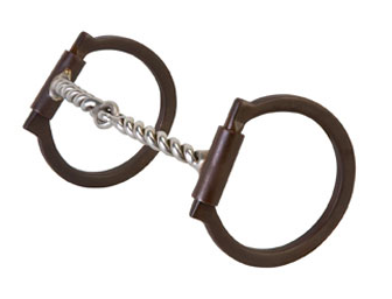
2) sometimes a twisted snaffle, if the horse is dull before it can counter bend. Mouth piece should be the same diameter as the regular snaffle, not thinner.
27 Comments
Leave a Comment

FREE PDF DOWNLOAD
WHY IS MY HORSE...?
100% Private - 0% Spam
No one taught you the skills you need to work through these things.
Riders often encounter self-doubt, fear, anxiety, frustration, and other challenging emotions at the barn. The emotions coursing through your body can add clarity, or can make your cues indistinguishable for your horse.
Learning these skills and begin communicating clearly with your horse.
Click here to learn more.

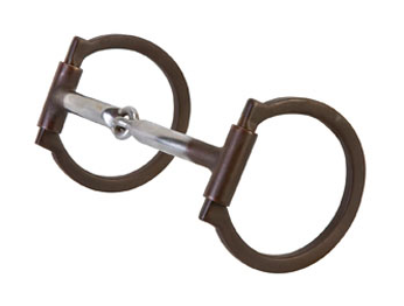
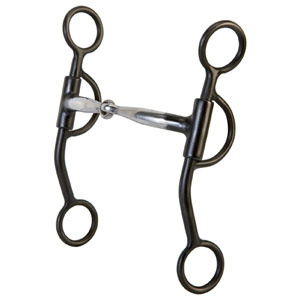
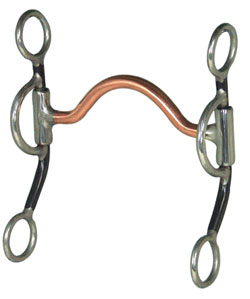
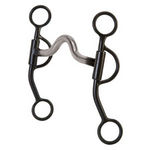
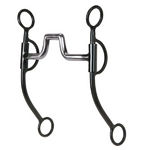
Hi Stacy. I came across a discussion in a forum where a person is using a paragraph of your article to try and prove a point in a way of training that I know you would be against as it goes against everything I have read and learned from you. If you could please write a response that either I can post for you or respond to them directly I would be more than thankful. Wevsite: http://www.horsegroomingsupplies.com/horse-forums/halter-v-bridle-bit-v-no-bit-542879-13.html#post7688607
Tara, thanks for sharing that link. It was an interesting read. I actually read the whole thread. I didn’t even think about people pulling stuff off the blog and using it that way…lol. Further down the page another person posting actually came back and quoted the whole blog and pointed out the same thing that you did. I’m glad I read it but I think it cleared itself up by the end of the thread. Thanks for showing me!
[…] What bit should I use with my horse? Why don’t you always use a snaffle bit? Doesn’t a bit hurt … […]
Bits are not what hurt the horse.It’s the human connected to the reins that are what makes the difference between hurting horse & using bit correctly.Stacy knows we use our whole body & mind to ride, not just our hands .Different bits serve different purposes, but still knowing how much pressure is enough & when to release & with what kind of pressure ,when to pick up hands,etc….. Using correct hand ,leg , body pressure & release. Also known as good timing. Any bit is severe in the wrong hands ….
[…] with the knowledge I have now, leads me to believe that not all horses are bitless candidates. Bits are motivators, horses are individuals and situations […]
Hi Stacy (and others),
I am new here, so sorry if this is answered somewhere else on the site (if it is please direct me to it!)
This is great information and I have been struggling with this issue with one of the horses I ride – I think changing bits may help. The horse is educated but falls into the “Employee Three” category on a few tasks/skills (not all of them, thank goodness).
How would one go about choosing a bit to try? Should I just go ahead and see what works and what doesn’t? I don’t want to confuse the horse and/or make it worse in the process.
What signs should I be looking for – especially since I can probably expect some reaction and/or resistance, since we’re trying to change some long-standing bad habits? How do I tell whether I am working through resistance, or just making it worse with the wrong bit choice?
Thank you for the wealth of information on this website – it is very generous of you to share so freely with us. Love your work!
Kate-did you see that your question became todays blog? click here or the main page to read it!
YES – Thank you sooooo much!!!
Your advice was very useful, and I am also adding a reply to that thread about how things worked out…what a great community this is!
Thank you for sharing, I have been to a clinic demo with you in Massachusetts a few years back and your riding is amazing.
I do however think the way you describe the three employees is not a realistic picture of the horse. I’d rather compare it to the three bosses.
Boss One – talks to you, set reasonable goals, celebrates any success, puts demands and encourages any step of success
Boss Two – talks to you with no compassion, puts demands and measure results.
Boss Three – give orders, expect prompt results, leaves out any communication and encouragements, and are likely to use the whip.
I think employee one, two and three would perform best with Boss One.
You blog is about bits, I think a real good rider like you can use bit, preferably the gentler kind, I do not see myself capable to use bits yet.
Sunshine from the Caribbean
Stina
The best bit in a horses mouth is. “A little bit of knowledge.” Thanks for helping to educate horse owners out there.
Really, the Tom Thumb can be used as a snaffle when you clip your riens to the rings directly connected to the bit. Not something to get so upset about.
Lisa, have you configured your horse’s mouth for that bit? Measured width? Does she have a thick tongue? Low or high palate? Do you need to rethink your communication methods? Almost every time when a horse is fighting the bit, it is either dental problems or heavy hands and that’s after fitting one to her mouth properly. She is trying to avoid pain. Plain and simple. Best of luck to you 🙂
I’ve seen Stacy ride like the wind, my example for everyone is that a mental connection with the horse is 1st and foremost. I’ve ridden some horses with dead mouths because people yank on them constantly. My trainer was like that to the core. Once it’s done it’s really hard to undo. The reins and bit are tools, not to be misused. It’s a lot like over tightening a screw, it breaks.
I hate, hate, HATE to be this person, but the Tom Thumb is not a snaffle — it’s a jointed curb. Snaffles = no leverage. Curbs = leverage.
I believe that’s what Bonnie was saying… if the bit has shanks then it is not considered a true snaffle, it is considered a broken mouth curb bit OR a shanked snaffle OR a jointed curb or whatever they call them in your neck of the country. But as Stacy said, ANY bit can be harsh if in the wrong hands. Shanks do offer leverage but can be super duper mild in a pair of extra soft hands while snaffles offer no leverage but can be wicked in harsh hands. The important part is first to learn how to use each bit, second use the appropriate bit for the appropriate reason on each horse but above all else realize that the rider makes the equipment gentle or harsh so create in yourself a rider with hands worthy of using any bit.
The pictured bit is also not a Tom Thumb, let alone a snaffle…it’s an Argentine, or “Western Pelham,” if you will.
Amanda- LOL! I debated on what to call it because I know it is not a snaffle…but no matter where I go if I call it a ‘shanked snaffle’ people know what I mean…if I say a jointed curb or give it a name…then I spend time trying to get them to picture…the…shanked snaffle.
It does however cause some conversations like this one. It is my opinion that a new word has been created. A bit like the old meaning of the word gay vs the new meaning of the word gay. Or the word AWFUL which in the 1300s meant “inspiring wonder” and was a short version of “full of awe”…that isn’t the way I have ever heard the word awful used, lol.
What is your suggestion for the horse that puts their tongue over the bit in the beginning of training? I have a tennesse walking mare that was started with a side pull and she responded very well. When she was moved to a snaffle she immediately started chewing on the bit and putting her tongue over it. She doesn’t like tongue pressure and she will also grab the bit at times. I tried raising the bit and letting her wear it for 24 hours in the stall. She was very quiet with it initially but then started chomping and tongueing it again after riding her with it. It was obvious she was not happy. She is currently in a Myler combo bit with a high port and roller. The reins are set so the bit works like a direct pressure bit (no leverage). She works ok with this bit but still grabs it with her teeth. Any suggestions? She is healthy and teeth have been floated. I am only using her for trail riding.
Also a Tom Thumb curb needs to have a spacer bar between the shanks to keep them apart avoiding “nutcracker” action.
I have had the same problem Lisa with my younger gelding. I’m currently using a Mylar Combination port also but I use 2nd rein ring so using some leverage. He does much better with this set up than he did with a regular snaffle but is still fussy with his mouth – turns his head sideways, particularly when I lope – trying to evade, I suspect?? Or maybe grabbing the bit as your horse does??? His teeth have been floated also…
Lisa, I have the same problems with one of my horses. While not a permanent solution, we bought this rubber piece called a cheeker that has helped lift it so he can’t shove his tongue over. He does still throw it around and isn’t always quiet in his mouth with the bit but he, at least, can’t get it over.
Very nice write-up with a vast amount of information. Thank you for including “Any bit it is only as harsh as the hands that use it.”.
I believe you need to practice the “e-brake stop” during regular riding sessions. When you practice it, your horse knows what you are asking and how to respond.
Stacy, are you saying that the shanked bits are snaffle bits? That is what it sounds like. This is a misconception. Anything with a shank and not direct pull is a curb bit. ( accept for a gag bit. ) I know they call them snaffle bits but they really aren’t, which I am sure you know, but so many people don’t. )
Bonnie- Your not the only one to notice. Amanda and a few hundred others did too. Here is my response.
I debated on what to call it because I know it is not a snaffle…but no matter where I go if I call it a ‘shanked snaffle’ people know what I mean…if I say a jointed curb or give it a name…then I spend time trying to get them to picture…the…shanked snaffle.
It does however cause some conversations like this one. It is my opinion that a new word has been created. A bit like the old meaning of the word gay vs the new meaning of the word gay. Or the word AWFUL which in the 1300s meant “inspiring wonder” and was a short version of “full of awe”…that isn’t the way I have ever heard the word awful used, lol.
Bonnie, she did not specifically say that the Tom Thumb is a snaffle. She stated “technically this is not a snaffle bit because it has shanks.” So she did not call it a snaffle, it may come across that way, but she cleared it up in the end of the little statement under the picture.(:
[…] via What bit should I use with my horse? Why don’t you always use a snaffle bit? Doesn’t a bit hurt …. […]